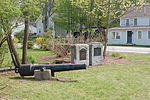County Farm Bridge (Wilton, New Hampshire)
1885 establishments in New HampshireBridges completed in 1885Bridges in Hillsborough County, New HampshireNational Register of Historic Places in Hillsborough County, New HampshireRoad bridges on the National Register of Historic Places in New Hampshire ... and 2 more
Stone arch bridges in the United StatesWilton, New Hampshire

The County Farm Bridge is a historic stone arch bridge in Wilton, New Hampshire. Built in 1885, it carries Old County Farm over Whiting Brook, just south of its northern junction with Burton Highway in a rural section of northwestern Wilton. It is an unusually late and well-preserved example of a 19th-century stone arch bridge, and was listed on the National Register of Historic Places in 1981.
Excerpt from the Wikipedia article County Farm Bridge (Wilton, New Hampshire) (License: CC BY-SA 3.0, Authors, Images).County Farm Bridge (Wilton, New Hampshire)
Old County Farm Road,
Geographical coordinates (GPS) Address Nearby Places Show on map
Geographical coordinates (GPS)
| Latitude | Longitude |
|---|---|
| N 42.856944444444 ° | E -71.8175 ° |
Address
Old County Farm Road 16
03086
New Hampshire, United States
Open on Google Maps









